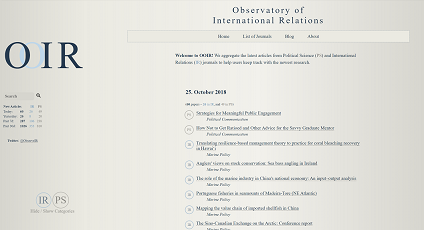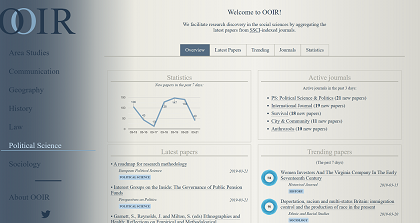Goals
OOIR conveys two major contents: research trends (based on altmetrics) and journal rankings (based on open, reproducible data) – both with a multidisciplinary outlook.
First, listing the scientific trends in (almost) real-time serves the goals of research discovery (helping scholars stay up-to-date with the latest findings) and scholarly communication (making the frontiers of scholarship discoverable to a general public). The altmetrics-based approach used here should enable serendipity and ultimately heighten the bibliometric variety of science.
Second, the journal rankings offer an alternative to traditional lists like the ones offered by Web of Science (based on the Journal Impact Factor) or Scopus. There are various differences: OOIR makes use of open citations deposited at CrossRef, a scholarly metadata-platform based on a Creative Commons license, allowing the rankings to be reproduced transparently. In addition, the time period that determines the rankings' outcomes cover four years (like an olympiad), which should do more justice to the tempo of scientifc publishing than the two or three years periods that are the standard in other platforms. Moreover, OOIR offers rankings based on multiple citation-based metrics, with the default one being the TQCC (or top quartile citation count) which may have some advantages over mere averages. Furthermore, the rankings are updated monthly and not just once a year. Finally, the data can be used freely under a CC0-license (including via an API).
How does it work?
OOIR retrieves metadata about scholarly articles via CrossRef. In addition, with the help of Altmetric, OOIR fetches data about the attention these papers obtain in non-scholarly channels.
For technical details, take a look here.
What does OOIR stand for?
Initially, in summer 2018, it was called Observatory of International Relations because the website was intended to serve the field of IR (International Relations) only. However, it soon expanded to cover other social science disciplines (Political Science, Sociology, Law, Communication, Area Studies, History and Geography). Since 2023, OOIR seeks to cover all disciplines, including the STEM ones. Perhaps the acronym OOIR stands for Observatory of International Research now.
Since when?
OOIR first went online in summer 2018. Back then, it only covered Political Science and International Relations; it looked like this, only listing the latest (rather than trending) papers:
In 2019, OOIR added further categories as well as a list of trending papers after a re-design, which looked like this:
The current design of OOIR went online in autumn 2019, and the multidisciplinary scope (spanning all kinds of scholarly disciplines) is a novelty added in early 2023.
Who?
OOIR is a hobby project created and operated by Andreas (Nishikawa-)Pacher. You can contact him via [email protected]. Questions, comments and feedback are very welcome!
Is OOIR free?
Yes; OOIR is a hobby project that is 100% free to use.
Since the end of 2021, the website contains Google Ads with which it is hoped that at least the costs of hosting can be covered. In addition, since 2023, OOIR offers the possibility to have journals added – and as it requires some manual work, a little compensation of €33,- will be asked for (see here for details).


